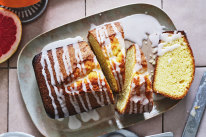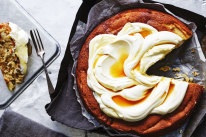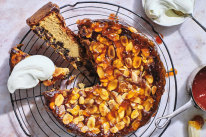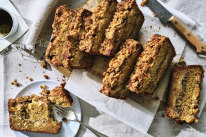Helen Goh's pandan napkin cakes with coconut custard
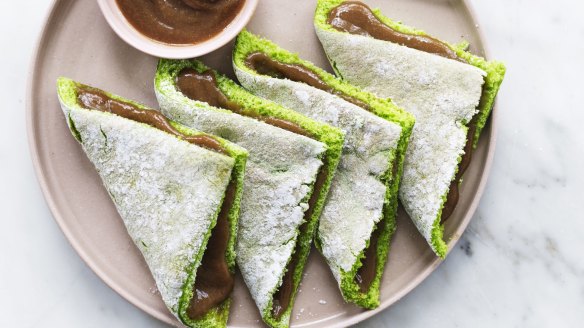
Inspired by the Portuguese napkin cake (guardanapos), my version uses pandan to flavour the sponge and is filled with kaya (Malaysian coconut custard) in place of the traditional doce de ovos (egg yolk cream). But there's no need to limit yourself to these pairings: replace the pandan extract with 1 teaspoon of vanilla essence for the little "napkins" and fill them with a dollop of jam and whipped cream for a simpler but no less delicious variation.
Ingredients
For the kaya (coconut custard)
3 eggs
100g light brown sugar
50g dark brown sugar
150ml thick coconut milk
¼ tsp fine salt
1 pandan leaf, folded and tied in a knot
For the sponge cake
2 eggs plus 5 egg yolks (save the egg whites*)
100g caster sugar
¼ tsp salt
½ tsp pandan extract (I use Koepoe brand, available from Asian grocers or online)
40g plain flour
icing sugar, for dusting
Method
1. Begin by making the kaya a few hours (and up to 3 days) before baking the sponge cake. Set up a steamer by placing a small trivet or wire rack at the bottom of a stockpot for which you have a tight-fitting lid. Fill with enough water to almost reach the trivet and bring to a boil over high heat. Once boiling, turn heat down to low.
2. Place eggs and brown sugars in a medium mixing bowl and whisk until combined. Add the coconut milk and salt, and whisk again until the sugar has dissolved, then strain the mix into a 1-litre heatproof bowl. Add the pandan leaf, then cover the bowl with a double layer of clean muslin or tea towel. Secure the cloth with string or rubber bands, then carefully lower the bowl onto the trivet in the steamer. Place the lid tightly on the pot and steam over low heat for 30 minutes, until the custard is just set. Remove from the steamer and allow to cool completely before refrigerating until needed.
3. To make the sponge cake, preheat the oven to 170C fan-forced (190C conventional). Line the bottom of a large oven tray (approximately 40cm x 33cm, to accommodate the 12 10-centimetre "napkins" described in step 7) with baking paper; do not line or grease the sides.
4. To make the cake, combine the eggs, yolks, sugar and salt in the bowl of a cake mixer. Whisk on high speed for 8-12 minutes or until the sugar has dissolved and the mixture has tripled in volume. Add the pandan extract and beat on medium speed until there are no green streaks visible. Remove bowl from the mixer, sift the flour directly into the batter and fold gently with a spatula to incorporate.
5. Scrape the batter evenly into the prepared baking tray and bake for 10-12 minutes, or until the cake bounces back when lightly pressed.
6. Cool the oven tray on a wire rack for 10 minutes.
7. Use a knife to edge around the sides to release the cake. With the cake still on the oven tray, sift some icing sugar lightly on top, then cover with a piece of baking paper. Place a large cutting board on top of the baking tray and flip over to release the cake. Carefully peel off the first layer of baking paper, then cut the cake into 12 even squares of 10 centimetres. (Depending on the size of your oven tray, you may have some offcuts or end up with fewer than 12 squares.)
8. Place a spoonful of the chilled coconut custard in the middle of each square, spread lightly, then gently fold the sponge diagonally so that two points join. To serve, arrange the napkin cakes, slightly overlapping, on a serving plate.
*Hint: freeze leftover egg whites in a small container and keep them for my next recipe in a fortnight!
Appears in these collections
The best recipes from Australia's leading chefs straight to your inbox.
Sign up
